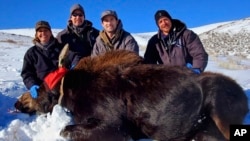Nevada is planning its first-ever moose hunting season this fall, which will feature a small-scale big game hunt for some of the largest animals in North America.
Wildlife managers say the explosive growth of Nevada’s moose population in the past five years, which has surpassed 100 animals, justifies the planned small harvest.
Scientists say such experiments could also provide a real-time look at how the complexities of climate change are affecting wildlife, and why these majestic — and some say silly-looking — mammals the size of horses are unexpectedly moving Their range expanded into warmer areas.
“Moose are a newcomer to North America,” said Cody McGee, Nevada Division of Wildlife Specialist.
McKee said moose were the last deer species to cross the Bering Sea land bridge into Alaska and Canada, with moose entering the Lower 48 occurring almost exclusively in the past 150 years.
“Their postglacial range expansion isn’t really complete yet,” McKee said. “That’s what we’re seeing in Nevada right now, where those moose are moving into the state and looking for suitable habitat.”
In an area larger than Massachusetts and New Jersey combined, only a few Nevada moose, maybe just one, would be killed. But state officials expect thousands of applications for the handful of hunting tags, which have already caused controversy.
“Why hunt moose?” asked Stephanie Myers of Las Vegas at a recent wildlife commission meeting. “We want to see moose, watch moose. Not kill moose.”
The first moose were spotted in Nevada in the 1950s, and soon after the dim-witted cartoon character Bullwinkle made his television debut. Only a handful of sightings occurred for decades, but began to increase about a decade ago.
By 2018, officials estimated there were 30 to 50, all in the northeastern corner of Nevada. But their numbers have more than doubled, and experts believe there is enough habitat to support about 200 individuals, a level that could be reached within three years.
Bryan Bird, Southwest program director for Defenders of Wildlife, is one of the skeptics and suspects this is a short-lived phenomenon.
“I believe the moose story is one of ‘ghost’ habitat or ‘ghost’ range expansion. What I mean is that these animals are expanding into habitats that may no longer be suitable in 50 years because of climate change,” Burr De said.
Government biologists admit they don’t fully understand why moose migrate so far south, where seasonal conditions are warmer and drier than they traditionally prefer.
“This seems to be the opposite of what we would expect for moose expansion, given their ecology,” said Marcus Blum, a researcher at Texas A&M University hired to help assess future migrations. He analyzed aerial surveys, personal sightings and habitats to predict growth trends.
Standing 1.8 meters tall at the shoulder and weighing up to 453.5 kilograms, moose live in riparian areas, chewing berry bushes and aspen leaves on the edges of mountain forests in the northern half of Nevada.
They usually avoid places where temperatures regularly exceed 20 degrees Celsius.
Blum said the Nevada study documented that moose spend nearly half of their time in areas above the “heat threshold” for about 150 days per year, and climate change models suggest that by 2050, that threshold will be exceeded for more than 150 days per year. 14 days.
To be clear, the valley beneath the snow-capped winter mountains, 805 kilometers from the Las Vegas Strip, is what many imagine the Nevada Desert to be.
McGee said researchers have more questions than answers about why moose continue to expand their range into Nevada, where a long drought has taken a toll on other wildlife.
“There’s a lot of speculation and questions about why they’re getting here, given how the environment is changing and the climate is likely getting warmer and drier,” McKee said. “Why don’t our widespread drought cycles seem to be affecting moose populations?”
The population along the U.S.-Canada border has fluctuated for more than a century. Some states, from Idaho to Minnesota and Maine, sometimes drastically reduce hunting quotas to allow populations to recover.
Alaska is home to the vast majority of moose in the United States, with more than 200,000 in number, and about 7,000 moose are harvested annually. Maine has nearly 70,000 licenses, five times more than the rest of the lower 48 states, and issued 4,100 licenses last year. Neighboring New Hampshire offers just 35 moose for a population of more than 3,000, and Idaho offers about 500 moose for a population of 10,000 to 12,000.
Before the 1960s, no moose were observed in Washington state, but their numbers have continued to increase and currently number over 5,000. The state issued three hunting licenses in 1977 and now issues more than 100 hunting licenses each year.
McKee said Nevada research shows the state’s population can handle a larger harvest than planned, but “conservatism is the name of the game here.”
Since 2020, aerial surveys are supported by radio tracking collars, which biologists have placed on four bull moose and nine cattle. In some places, males significantly outnumber females. Removing one or two bulls may improve herd dynamics, he said.
The exact number of licenses will be determined in the coming weeks, but McGee doesn’t expect more than three. Only Nevadans can apply for the first hunt, which will help guide decisions about future efforts.
Successful hunters must submit the skull and antlers to the state for inspection within five days. This will give scientists a deeper understanding of cattle health, body condition, disease and parasites.
Bill Nolan of Sparks, who first hunted ducks when he was 12, said he planned to apply for what he described as a “slim” chance of drawing a moose.
“For a hunter, it’s like winning the lottery,” he said.
Follow us on Google news ,Twitter , and Join Whatsapp Group of thelocalreport.in
